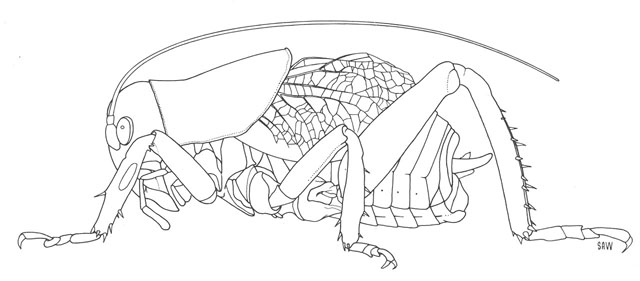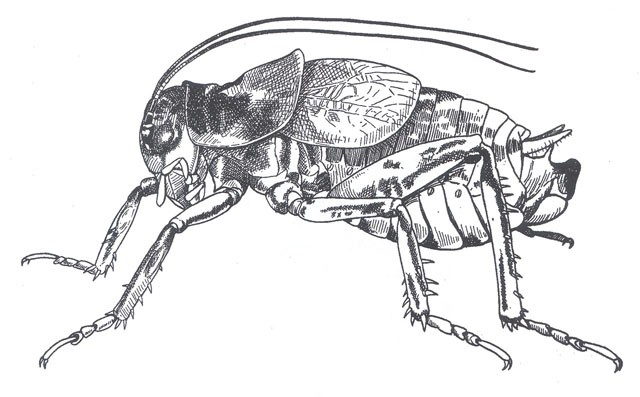Hump-Backed Grigs:
Cyphoderris buckelli. Buckell’s Grig. Drawing of male
by Susan A. Wineriter, University
of Florida.
Cyphoderris monstrosa. Great Grig. Drawing of male, by
Mary Foley Benson. Fig. from Gurney 1939.
Hump-Backed Grigs
come from the family Prophalangopsidae, and there are three species that are
found in North America, all of which are in
the genus Cyphoderris. They can be found in coniferous forests, or in
high altitude sagebrush in the north western part of the United States, and extending up into Canada.
Hump-Backed Grigs
are nocturnal insects, and are rarely found during the day. They hide in
burrows, but come out at night. The males are found chirping away on tree
trunks or anything else that protrudes from the ground. They always sit head
down when chirping, and through the night will climb higher and higher until
they are out of reach.
It’s easy to tell
whether an adult grig is a male or a female. If the grig’s wings cover half or
more of its abdomen, then it’s a male. But if its wings are miniscule, then it
is either a female, or if it is small, then it is a nymph.
One interesting
thing is that it’s also pretty simple to figure out whether a male has mated
yet or not. You just lift up the upper wings to uncover the hind wings, and if
the hind wings are damaged at all, the male has mated before, but if the hind
wings are undamaged, then the male is a virgin. The reason for this is because
when grigs mate, the female will chew on the hind wings of the male.
The chirping is a
high pitched trill that lasts several seconds, stops for a moment, then starts
again. “Eeeeeeeeeeee! Eeeeeeeeee! Eeeeeeee!” The sound can be a little
unnerving, as it sounds anything but nice, and even the sight of these
creatures aren’t that friendly, but they really are quite harmless.
You can hunt them
at night by following their sound, but if you flash them with a light, they
will stop their song, and will not start up again for a few minutes. The way I
hunt them is I either shine the light on the ground in front of me or don’t
have my light on until I pinpoint what tree the grig is on. Once you have
pinpointed the tree the grig resides on, you can search the trunk with your
light.
Again, though they
look quite fierce, they are quite harmless, and will only bite if grabbed the
wrong way. The bite doesn’t even hurt, but is merely a little surprising, and
may cause you to drop the grig. Just grab it by its thorax with its legs held
against its body, and drop into an awaiting container.
The succession of
trills produced by the male are made at wing stroke rates of 50-75 (at 77 ºF) a
second. The forewings have both a “file” and “scraper” which produce the sound,
and will amplify and broadcast the trills; the right and left forewings both
have equally developed files and scrapers. They will alternate between which
wing is on top at rest. To what extent the grig will switch between the left
and right files is not established. This action is called “switch wing
stridulation”.
Though scientists
have separated the genus Cyphoderris into three species, it is most
likely that all came from the same created kind. There are only very minor
differences between the three different species, but it is still interesting to
examine these, and to see what diversity God has put in his creation.
The species of grig
that will be found in the Cascades of Oregon and Washington,
and specifically Paulina
Lake, will most likely be
the Great Grig (Cyphoderris monstosa). But just in case of undocumented
biogeography, here’s a key that shows some subtle, but interesting differences:

Lateral view of male subgenital plates of Cyphoderris.
Fig. from Morris & Gwynne 1978.
Not only are the
back ends of the three species different, but their songs too. The songs of C.
strepitans and C. buckelli are nearly indistinguishable, but there
is a difference between the song of C. monstrosa. At any temperature, C.
monstrosa has the higher pulse rate. Though a grig’s song is not as reliable
as the Snowy Tree Cricket’s chirp is, it does follow a pattern. The warmer it
is, the more pulses per second.
Relation of pulse rate and temperature in the calling
songs of hump-winged grigs. (S is from Spooner 1973.) Fig. from Morris &
Gwynne 1978 (slightly modified). Converted to Fahrenheit.
Truly God has blessed us with a diverse and
abundant amount of creatures. Everywhere we go we find different kinds of
insects. In some places you might find field crickets, other places tree
crickets, or katydids, or even cicadas. And last, in the Cascades and
elsewhere, you find the Hump-Backed Grigs. God has created a symphony for us to
enjoy at night, and to lull us to sleep. God is wonderful!


No comments:
Post a Comment